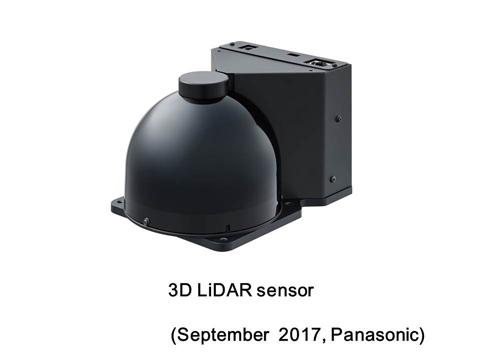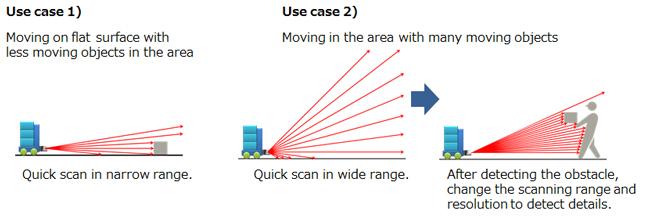
Dec 25, 2025
- Products & Solutions
- Stories
- Technology
- AI & Robotics
- R&D
- Business Solutions
Sep 11, 2017
Products & Solutions / Press Releases
Panasonic's new 3D LiDAR enables variable detection settings for viewing angles and scanning speed. This new product contributes to the wide-spread use of autonomous robots that navigate inside or outside facilities with moving objects, including people.

Osaka, Japan - Panasonic Corporation announced today that it has developed a 3D LiDAR [1] sensor that accurately measure the direction of and distance to objects with a wide angle of view, which is critical for autonomous operation of mobile robots. Employing Panasonic's propriety laser-scanning technology, this 3D LiDAR is capable of scanning the laser as wide as up to 60 degrees vertically and 270 degrees horizontally to achieve stable operation of autonomous robots. Sample shipments will start in January 2018. Panasonic will exhibit the 3D LiDAR at "CEATEC JAPAN 2017" at Makuhari Messe, Chiba, Japan, from October 3 to 6, 2017
The wide scanning angle of the newly developed 3D LiDAR helps the detection of objects on the ground precisely as well as the roughness of the ground surface. In addition, the range of scanning angles and the resolution can be tailored precisely by adjusting the rotation angle and speed of the mirrors in the system. This feature gives users accuracy and flexibility to choose the most appropriate conditions for the measurement depending on their usage. That will facilitate the wide-spread use of autonomous robots[2] that navigate inside or outside facilities with moving objects around, including people.
Autonomous robots need to detect the condition of the ground as well as the objects around them since they will be operated inside and/or outside facilities with many moving objects including people. Conventional 3D LiDARs that are designed for autonomous driving of automobiles cannot scan the laser in a wide range of vertical angles. Therfore, they cannot precisely detect the conditions of the ground. For this reason, conventional LiDARs need to be combined with other sensors that can detect the ground condition. This results in complicated configuration and the design of the autonomous robots.
Autonomous robots such as delivery robots; fork lifts; agricultural machinery; construction machinery; and security systems.
Existing 3D LiDARs cannot detect objects around them with wide view angles especially for the vertical direction. Panasonic developed the laser-scanning technologies utilizing its proprietary design of optical system and motor controlling technology to move the mirror that have been developed for the mass production of optical disk drives. The 3D LiDAR employs a single laser and moving mirror for the detection. Laser light travels the same optical path in the Panasonic's original optical system. The mirror moves toward two different directions by two motors. The single-path design and wide angle of the mirror-move enable wide view angles with 60 degrees in vertical and 270 degrees in horizontal directions. The 3D LiDAR does not require any additional sensors for the detection of the objects around including those on the ground, which makes the detection system in autonomous robots very simple.

Autonomous robots are required to detect the objects in the specified area. For example, autonomous robots do not need to sense the objects in details when they move on flat surface with less objects in the area. The object detection sensor can be scanned at relatively high speed according to the robot's speed. On the other hand, in an area with many moving people or objects, it requires high sensing technologies with a wide angle of view. Furthermore, the sensor needs to examine the details of the object's surface that has been detected. Panasonic's new 3D LiDAR can easily vary the detection settings thanks to its unique laser-scanning technologies employed. Stable and time-effective operations of autonomous robots can be achieved by choosing the most suitable detection settings depending on the conditions of the areas where they will be used.

Autonomous robots also require the accuracy in detectiing objects under strong sunlight. By making the return light follow the same path as the emitted laser, Panasonic has successfully reduced the noise induced by bright sunlight. As a result, the newly developed 3D LiDAR can be operated with high accuracy even under the light intensity of 100,000 lux [3] that corresponds to strong sunlight in summer-time.

| Item | Performance |
|---|---|
| Scanning angle | 270 degrees in horizontal and 0 to 60 degrees in vertical direction (variable) |
| Resolution in vertical angles | Can be chosen from three modes of 1.5 degrees, 3.0 degrees and 7.5 degrees. |
| Detectable distance | 0.5 m to 50 m |
| Frame rate | 5 fps to 25 fps |
| Ambient light immunity | Up to 100,000 lux (under sunlight) |
| Outside dimensions | 130 mm (H) x 120 mm (W) x 140 mm (D) |
Panasonic Corporation is a worldwide leader in the development of diverse electronics technologies and solutions for customers in the consumer electronics, housing, automotive, and B2B businesses. Celebrating its 100th anniversary in 2018, the company has expanded globally and now operates 495 subsidiaries and 91 associated companies worldwide, recording consolidated net sales of 7.343 trillion yen for the year ended March 31, 2017. Committed to pursuing new value through innovation across divisional lines, the company uses its technologies to create a better life and a better world for its customers. To learn more about Panasonic:
http://www.panasonic.com/global
Panasonic Corporation
Tel: +81-(0)3-3574-5664
The content in this website is accurate at the time of publication but may be subject to change without notice.
Please note therefore that these documents may not always contain the most up-to-date information.
Please note that German, Spanish and Chinese versions are machine translations, so the quality and accuracy may vary.